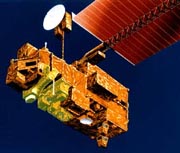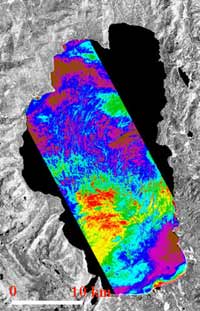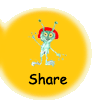|
Infrared
waves are just like visible light, except longer . . . too
long for our eyes to see.
Our
eyes see light waves that are not too short, not too long,
but just right within a tiny range of sizes.
 
Infrared
waves are too long for our eyes to see, but warm objects are
sending them out all the time. So we see light from a
lightbulb, but we don't see the heat from the lightbulb.
As
you can see, things "look" very different in infrared. All
we need is a special infrared-detecting
instrument.
 If
we could put such an instrument in orbit around Earth, we
could find out all kinds of useful things. ASTER (which
stands for Advanced Spaceborne Thermal Emission and
Reflection Radiometer) was launched into orbit on December
18, 1999. If
we could put such an instrument in orbit around Earth, we
could find out all kinds of useful things. ASTER (which
stands for Advanced Spaceborne Thermal Emission and
Reflection Radiometer) was launched into orbit on December
18, 1999.
Information
from ASTER will be used to . . .
- study
oceans, lakes, and rivers
- observe
volcanos, especially ones near cities and
villages
- look
for things in the ground, such as metals, oil, water, and
earthquake faults
- help
keep track of glaciers, which are like rivers of solid
ice. ASTER will show whether they are melting, growing,
or moving.
 This
picture of Lake Tahoe (on the California/Nevada border) was
taken from an aircraft. But the colorful part of the lake is
an infrared image that has been color-enhanced. Purple and
blue show the coldest parts of the lake, while yellow and
red are the warmest. This
picture of Lake Tahoe (on the California/Nevada border) was
taken from an aircraft. But the colorful part of the lake is
an infrared image that has been color-enhanced. Purple and
blue show the coldest parts of the lake, while yellow and
red are the warmest.
|


 If
we could put such an instrument in orbit around Earth, we
could find out all kinds of useful things. ASTER (which
stands for Advanced Spaceborne Thermal Emission and
Reflection Radiometer) was launched into orbit on December
18, 1999.
If
we could put such an instrument in orbit around Earth, we
could find out all kinds of useful things. ASTER (which
stands for Advanced Spaceborne Thermal Emission and
Reflection Radiometer) was launched into orbit on December
18, 1999. This
picture of Lake Tahoe (on the California/Nevada border) was
taken from an aircraft. But the colorful part of the lake is
an infrared image that has been color-enhanced. Purple and
blue show the coldest parts of the lake, while yellow and
red are the warmest.
This
picture of Lake Tahoe (on the California/Nevada border) was
taken from an aircraft. But the colorful part of the lake is
an infrared image that has been color-enhanced. Purple and
blue show the coldest parts of the lake, while yellow and
red are the warmest.




